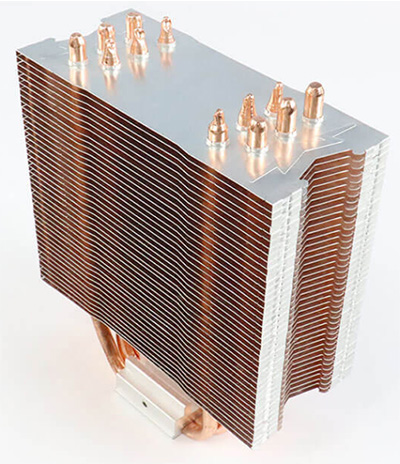

There are many kinds of computer radiators, and each radiator is developed based on each generation of computer CPU chips to seek more suitable heat dissipation power and service life. Most radiators used in any product are divided into air-cooled and water-cooled. Generally, the same heat dissipation modes are only different in size, material and structure, and then the effect is different. But the only truth is that any product needs to pursueits lifetime, that is to say, the radiator is also the same, while ensuring heat dissipation, there is a certain margin to achieve the possibility of prolonging product lifetime.
Yuanyang thermal developed the copper-aluminum composite Fin chip computer radiator,and the specific parameters are as follows:
|
Product Name |
CPU copper-aluminum composite Fin chip computer radiator |
|
Specification |
120*150*53mm |
|
Product Code |
YY-HS-052 |
|
Material |
Copper and material |
|
Radiator Power |
260W(with Fan) |
|
The heat pipe quantity |
6 heat pipes |
|
The platform of heat sink |
Intel LGA 115X/775/1366;AMD FM1/FM2/AM4/AM3 |
|
Surface treatment |
Oil cleaning |
|
The advised fan |
120mm standard fan |
Product Pictures Shown As Below


Product Characteristic:
1. Because of the adoption of copper-aluminum composite fin sheet, it can not only ensure the increase of thermal conductivity and heat dissipation power of the product, but also effectively save the product cost, especially in mass production.
2. The product has a brand-new appearance and attracts some attention. Copper-aluminum composite is also a new technological approach and new discovery.
3. The durability of the product is longer than that of all-aluminum fin. Because copper itself has longer durability, it plays a unique advantage in radiator fin.
4. The machining difficulty is not toohard. As long as the corresponding fitting fixture is equipped, the manual operation with the machine is simple and convenient.
The Test Result From Equipment

In the computer test, it is found that the performance of the radiator will rise to above 60 degrees at the beginning of high operation, but in the general daily experiment, with the help of the cooling of the radiator, the temperature is controlled at around 30 degrees to 40 degrees, which is still very stable without excessive amplitude.